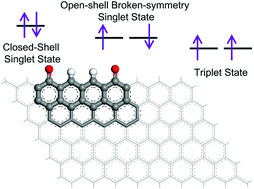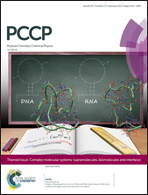Magnetism-tuning strategies for graphene oxide based on magnetic oligoacene oxide patches model†
Abstract
Graphene oxide (GO) has wide application potential owing to its 2D structure and diverse modification sites for various targeted uses. The introduction of magnetism into GO structures has further advanced the controllability of the application of GO materials. Herein, the concept of modular design and modeling was applied to tune the magnetism of GO. To obtain desirable magnetic properties, diradical-structured GO patches were formed by the introduction of two functional groups to break the Kekule structure of the benzene ring. In these diradical GO patches, the energy of the triplet state was lower than those of the open-shell broken-symmetry singlet state and closed-shell singlet state. To create such multi-radical patches, a practical approach is to determine a substantial spatial separation of the α and β spin densities in the molecule. Thus, systematic design strategies and tests were evaluated. The first strategy was extending the distance between the distribution center of the α and β spin densities; the second was controlling the delocalization directions of the α and β electrons; the third was controlling the delocalization extension of the α and β electrons by oxidative modification, and finally introducing multi-radical structures into the molecular system and controlling the position of each radical. Herein, successful molecular models with a large magnetic coupling constant (∼3600 cm−1) were obtained. This study paves the way to explore ferromagnetic MGO guided by theoretical study, which may become reality soon.



 Please wait while we load your content...
Please wait while we load your content...